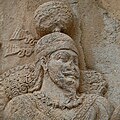پرونده:Shapur II (4684721120) (Cropped).jpg

پروندهٔ اصلی (۲٬۷۳۶ × ۲٬۷۴۴ پیکسل، اندازهٔ پرونده: ۲٫۷۵ مگابایت، نوع MIME پرونده: image/jpeg)
این پرونده در ویکیانبار موجود است. محتویات صفحهٔ توصیف آن در زیر نمایش داده میشود. |
خلاصه
| توضیحShapur II (4684721120) (Cropped).jpg |
Detail of king Shapur II on his relief at Taq-e Bustan The rock relief of Sasanian king Shapur II (309-379 CE) at Taq-e Bostan, also known as Taq-e Bustan I shows a double scene of investiture and victory. Shapur II is the first king who ordered the carving of a rock relief at Taq-e Bustan. The reason of such choice may be explained by several facts: a lake is at the footage of the rocky cliff, flooded by several springs, the place is located on a millenniums-used road having linked Babylon to Ecbatan under the Median and later Achemenian era, Seleucia and Hecatompylos under the Parthian, then, Ctesiphon to Kermanshah under the Sasanian ruling. Carved in a rectangular frame, the relief is symmetric, king standing at the center. At the left side, God Mithra emerges from a Lotus flower, crowned by a lightning sun, holding the Barsum (wood bundle symbol of divine power). At the right side, god Ahuramazda wearing his classical crenellated crown gives the king the Farshiang ( ribboned ring symbol of royal power). Under the feet of the king, lay the dead body of Roman emperor Julian the Apostate, who was defeated by Shapur II. The characters are isocephalic ( even Mithra standing above a flower): their heads are on the same level suggesting the king is equal to gods. The relief shows the first representation of a new royal posture: standing frontal body with divergent feet and semi-turned head. Although taken as a whole, the scene looks static, but a detail gives the composition a subtle movement: a closer look at the ring Ahuramazda gives to the king let one see that the god’s hand is closed, holding the ring while the king’s hand is yet open waiting for it. The short angle given to the king's body conjuguated with the rotation of his head & upper body towards Ahuramazda complete the movement. Technically speaking the quality of the carving is very fine, showing that the Sasanian artists have matched a constant progress within time: the depth is clearly increased compared to previous reliefs, while clothes, weapons, crowns, jewels and body details get more realism. Except… The Roman emperor. Leaving aside the realism of his face and clothing reminding those seen on his coinages, Julian the apostate is minimally engraved, with a poor depth, as if the king ordered to suggest a defeated roman enemy was of a lesser importance. The surface of the relief is not smooth, appearing grainy or slightly bumpy. If natural erosion could be an explanation, clues have been found on some Sasanian rock reliefs letting archaeologists think that some reliefs may have been coated with kind of plasters or pigments that could not be applied on smooth surfaces. Taken at Taq-e Bustan, city of Kermanshah, Province of Kermanshah, Iran, May 2009. See also: Rock relief of Shapour II at Taq-e Bustan, frontal view Rock relief of Shapour II at Taq-e Bustan, side view God Ahuramazda on the rock relief of Shapour II at Taq-e Bustan God Mithra on the rock relief of Shapour II at Taq-e Bustan Detail of dead emperor Julian the Apostate on the rock relief of Shapour II at Taq-e Bustan Detail of the lotus flower on the rock relief of Shapour II at Taq-e Bustan |
|||
| تاریخ | ||||
| منبع | Shapur II | |||
| پدیدآور | dynamosquito from France | |||
| دیگر نسخهها |
|
| مختصات دوربین | ۳۴° ۲۳′ ۲۲٫۱۵″ N, ۴۷° ۰۷′ ۱۰٫۸۳″ E | محل قرارگیری این نگاره و سایر نگارهها در: نقشهٔ شهری باز |
|---|
اجازهنامه
- شما اجازه دارید:
- برای به اشتراک گذاشتن – برای کپی، توزیع و انتقال اثر
- تلفیق کردن – برای انطباق اثر
- تحت شرایط زیر:
- انتساب – شما باید اعتبار مربوطه را به دست آورید، پیوندی به مجوز ارائه دهید و نشان دهید که آیا تغییرات ایجاد شدهاند یا خیر. شما ممکن است این کار را به هر روش منطقی انجام دهید، اما نه به هر شیوهای که پیشنهاد میکند که مجوزدهنده از شما یا استفادهتان حمایت کند.
- انتشار مشابه – اگر این اثر را تلفیق یا تبدیل میکنید، یا بر پایه آن اثری دیگر خلق میکنید، میبایست مشارکتهای خود را تحت مجوز یکسان یا مشابه با ا اصل آن توزیع کنید.
| این نگاره در ابتدا توسط dynamosquito در https://www.flickr.com/photos/25182210@N07/4684721120 به فلیکر ارسال شدهاست و در ۱۰ مه ۲۰۱۴ توسط ربات FlickreviewR بازبینیشده و اینکه نگاره تحت مجوز cc-by-sa-2.0 منتشر شدهاست تأیید شد. |
۱۰ مه ۲۰۱۴
عنوان
آیتمهایی که در این پرونده نمایش داده شدهاند
توصیفها
این خصوصیت مقداری دارد اما نامشخص است.
source of file انگلیسی
original creation by uploader انگلیسی
۱۱ اکتبر 2023
image/jpeg
checksum انگلیسی
da79831ff6f84dcb46e87f014315788fd396e483
۲٬۸۷۹٬۴۹۵ بایت
۲٬۷۴۴ پیکسل
۲٬۷۳۶ پیکسل
34°23'22.153"N, 47°7'10.826"E
تاریخچهٔ پرونده
روی تاریخ/زمانها کلیک کنید تا نسخهٔ مربوط به آن هنگام را ببینید.
| تاریخ/زمان | بندانگشتی | ابعاد | کاربر | توضیح | |
|---|---|---|---|---|---|
| کنونی | ۱۱ اکتبر ۲۰۲۳، ساعت ۱۳:۵۱ |  | ۲٬۷۳۶ در ۲٬۷۴۴ (۲٫۷۵ مگابایت) | AR VLD | Uploaded own work with UploadWizard |
کاربرد پرونده
صفحهٔ زیر از این تصویر استفاده میکند:
کاربرد سراسری پرونده
ویکیهای دیگر زیر از این پرونده استفاده میکنند:
- کاربرد در mzn.wiki.x.io
فراداده
این پرونده حاوی اطلاعات اضافهای است که احتمالاً دوربین دیجیتال یا پویشگری که در ایجاد یا دیجیتالی کردن آن به کار رفته آن را افزوده است. اگر پرونده از وضعیت ابتداییاش تغییر داده شده باشد آنگاه ممکن است شرح و تفصیلات موجود اطلاعات تصویر را تماماً بازتاب ندهد.
| جهت | عادی |
|---|---|
| نرمافزار استفادهشده | Microsoft Windows Photo Viewer 6.1.7600.16385 |
| تاریخ و زمان تغییر پرونده | ۱۱ اکتبر ۲۰۲۳، ساعت ۱۶:۳۴ |
